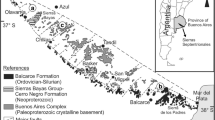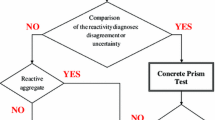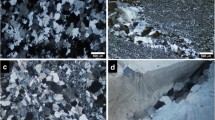Abstract
A universal accelerated test for both alkali-silica and alkali-carbonate reactivity was proposed based on extensive comparative studies on existed Accelerated Mortar Bar Test (AMBT), (e.g., ASTM C1260, CSA A23. 2–25A, RILEM TC191-ARP-AAR02) and Chinese accelerated procedures. A single size fraction of 2.5–5.0 mm aggregate particles is used in the test instead of five-graded requirements in the AMBT, and 0.15–0.80 mm fine particles for ASR, 5–10 mm particles for ACR in existed Chinese accelerated tests. Three short-fat bars, 40 × 40 × 160 mm, made at fixed cement-aggregate ratio of 1:1, and water-cement ratio of 0.33 are used and the length change of the bars is monitored till 28 days in 1 M NaOH solution at 80°C after being soaked in 80°C water for 24 h. Over 40 kinds of aggregates from various origins, which include both ASR and ACR aggregates and show a broad range of reactivity levels in the concrete prism test (CPT), were used to evaluate the reliability of the new test in this study. Experimental results indicate that, for ASR aggregates, the new test gives a better indication than the AMBT does of both the reactive/nonreactive characteristic and reactive levels of almost all tested aggregates based on an acceptance criteria of 0.093% at 14 days, although some very highly reactive aggregates show low expansions relative to the CPT. The “abnormal” low expansion of some highly reactive aggregate in the test is mainly due to the rapid formation and loss of fair amount of low viscosity ASR product into the soaking alkali solution. The results on some typical ACR aggregates usually undetected by the AMBT show that the new test gives the same outcome as using 5–10 mm particles in the Chinese Accelerated Concrete Microbar Test for ACR aggregates and is in agreement with the CPT, which suggests that it has good potentials to be used for ACR aggregate when an expansion criteria of 0.1% after 28 days is used.





Similar content being viewed by others
References
ASTM C 1260–94. Standard test method for determining the potential alkali reactivity of combinations of cementious materials and aggregate (accelerated mortar-bar method). Annual book of ASTM standards 2002, Vol 04.02. American Society for Testing and Materials, 1916 Race Street, Philadelphia, PA 19103
CSA A23.2–25A-00. Detection of alkali-silica reactive aggregate by accelerated expansion of mortar bars. CSA A23.2–00: methods of test for concrete. Canadian Standards Association, Mississauga, ON
RILEM Recommended Test Method AAR-2 (2000) Detection of potential alkali-reactivity of aggregates—the ultra-accelerated mortar-bar test. Mat Struct 33:283–289
Oberholster RE, Davies G (1986) An accelerated method for testing the potential alkali reactivity of siliceous aggregates. Cement Concrete Res 16:181–189
CSA A23.2–14A-00. Potential expansivity of aggregates (procedure for length change due to alkali-aggregate reaction in concrete prisms). CSA A23.2–00: methods of test for concrete. Canadian Standards Association, Mississauga, ON, pp 207–216
ASTM C 1293–01 (2002) “Standard test method for concrete aggregates by determination of length change of concrete due to alkali-silica reaction”, annual book of ASTM standards, Vol 04.02 (concrete and aggregates), Philadelphia, PA
RILEM Recommended Test Method AAR-3 (2000) Detection of potential alkali-reactivity of aggregates—method for aggregate combinations using concrete prisms. Mat Struct 33(229):290–293
Bérubé M-A, Fournier B, Mongeau P, Dupont N, Ouellet C, Frenette J (1992) Effectiveness of the accelerated mortar method, ASTM C-9 proposal P214 or NBRI, for assessing potential AAR in Quebec (Canada). Proceedings of the 9th International Conference on Alkali-Aggregate Reaction in Concrete, London, pp 92–109
Fournier B, Bérubé M-A (2000) Alkali-aggregate reaction in concrete: a review of basic concepts and engineering implications. Canadian J Civil Eng 27(2):167–191
DeMerchant DP, Fournier B, Strang F (2000) Alkali-aggregate research in New Brunswick. Canadian J Civil Eng 27(2):212–225
Marie de G, Eric F (2000) Evaluation of the potential alkali-reactivity of concrete aggregates: performance of testing methods and a producer’s point of view. Proceedings of the 11th International Conference on Alkali-Aggregate Reaction, Quebec, Canada, pp 267–276
Chau L, Chih CL, Wei CW (2004) An accelerated concrete prism soaking test for evaluating the alkali-reactivity of aggregates. Proceedings of the 12th International Conference on Alkali-Aggregate Reaction, Vol.1. Beijing, pp 273–281
Ranc R, Debray L (1992) Reference test methods and a performance criterion for concrete structures. Proceedings of the 9th International conference on AAR in concrete, London, UK, the concrete society, pp 824–830
Nixion PJ (chairman) (2006) RILEM recommended test method TC-106–4 (now AAR04): detection of potential alkali-reactivity of aggregates: accelerated (60°C) concrete prism test, RILEM TC191-ARP committee draft
Fournier B, Nkinamubanzi P-C, Lu D, Thomas MDA, Folliard KJ, Ideker JH (2006) Evaluating potential alkali-reactivity of concrete aggregates—how reliable are the current and new test methods? Proceedings of a symposium on alkali-aggregate reactivity in concrete honoring professoer Bérubé M-A, Montreal, Canada, pp 21–44
Tang M, Han S, Zheng S(1983) A rapid method for identification of alkali reactivity of aggregate. Cement Concrete Res 13(3):417–422
Criaud A, Vernet C, Defosse C (1990) The microbar method, an accelerated expansion test for evaluating aggregates—assessment of Canadian aggregates, Canadian Developments in Testing Concrete Aggregates for Alkali-Aggregate Reactivity. Ministry of Transportation, Ontario, Engineering Materials Report 92, pp 201–214
Tang M, Lan X, Han S (1994) Autoclave method for identification of alkali reactivity of carbonate rocks. Cement Concrete Composites 16:163–167
Xu Z, Shen Y, Lu D et al (1998) Main parameters in the new test method for alkali-silica reactivity. J Nanjing University of Chemical Technology (in Chinese) 20(2):1–7
Lu D, Fournier B, Grattan-Bellew PE (2006) Evaluation of accelerated test methods for determining alkali-silica reactivity of concrete aggregates. Cement Concrete Composite 28:546–554
Sommer H, Grattan-Bellew PE, Katayama T, Tang Mingshu (2004) Development and inter-laboratory trial of the RILEM AAR-5 rapid preliminary screening test for carbonate aggregates. Proceedings of the 12th International Conference on Alkali-Aggregate Reaction, Vol 1, Beijing, pp 407–412
Sommer H, Nixon PJ, Sims I (2005) RILEM TC-191-ARP AAR-5: rapid preliminary screening test for carbonate aggregates. Mat Struct 38:787–792
Lu D, Fournier B, Grattan-Bellew PE (2004) Evaluation of the Chinese accelerated test for alkali-carbonate reactivity. Proceedings of the 12th International Conference on Alkali-aggregate Reaction in Concrete, Vol.1, Beijing, pp 386–392
Grattan-Bellew PE, Cybanski G, Fournier B, Mitchell L (2003) Proposed universal accelerated test for alkali-aggregate reaction the concrete microbar test. Cement, Concrete Aggregates 25(2):29–34
Grattan-Bellew PE, Lu D, Fournier B, Mitchell L (2004) Comparison of expansions in the concrete prism and concrete microbar tests of in assorted suite of aggregates from several countries. Proceedings of the 12th International Conference on Alkali-Aggregate Reaction, Vol.1, Beijing, pp 251–256
Swenson EG (1957) A reactive aggregate undetected by ASTM tests. ASTM Bulletin 226. American Society for Testing and Materials, Philadelphia, pp 48–51
Rogers CA (1986) Evaluation of the potential for expansion and cracking of concrete caused by the alkali-carbonate reaction. Cement Concrete Aggregates 8(1):13–23
CSA A23.2–27A-00. Standard practice to identify degree of alkali-reactivity of aggregates and to identify measures to avoid deleterious expansion in concrete, CSA A23.2–00: methods of test for concrete. Canadian Standards Association, Mississauga, ON, pp 251–259
Rivard P, Fournier B, Ballivy G (2002) The damaging rating index method for ASR affected concrete—a critical review of the petrographic features of deterioration and evaluation. Cement Concrete Aggregate 24(2):1–11
Lu D, Fournier B, Grattan-Bellew PE (2006) Effect of aggregate particle size on determining alkali-silica reactivity by accelerated tests. J ASTM Int 3(9):1–11
Acknowledgments
The project was partially supported by the Jiangsu Provincial Department of Education under 05KJB430046 and SRF for ROCS, SEM.
Author information
Authors and Affiliations
Corresponding author
Rights and permissions
About this article
Cite this article
Lu, D., Fournier, B., Grattan-Bellew, P.E. et al. Development of a universal accelerated test for alkali-silica and alkali-carbonate reactivity of concrete aggregates. Mater Struct 41, 235–246 (2008). https://doi.org/10.1617/s11527-007-9232-2
Received:
Accepted:
Published:
Issue Date:
DOI: https://doi.org/10.1617/s11527-007-9232-2




